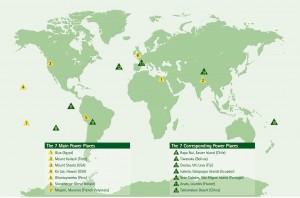Who built them?
The perfectly shaped megaliths are a characteristic of archaic structures. Giza, with its great pyramids and its many underground complexes was the center of the Egyptian, if not the global megalithic culture. All the textbooks, encyclopedias and scientific journals state as a fact that the pyramids in Giza were built by the pharaohs Cheops, Chephren and Mykerinos. Lay persons and Egyptology students alike tend to be astonished when they realize how weak the alleged proof for this theory is. The pharaohs Cheops, Chephren and Mykerinos never asserted in any texts that they built the pyramids. This topic is never addressed anywhere throughout the entire body of written Egyptian history. This all shows how careful one must be before attributing the building of the Great Pyramids of Giza to the pharaohs, who never claimed to have done so, and who indirectly refute this claim through their own silence. The Egyptologists arguments used to shore up their theory of the pharaohs as the builders of the megalithic structures at Giza (the pyramids, Sphinx, Valley Temple, etc), simply do not hold water. They arise from a preconceived worldview to which all previous discoveries have been subjected. However, if one frees oneself from this narrow point of view, then it becomes clear that there are other explanations for these magnificent structures that do better justice to the facts. The Egyptian megalithic culture holds many mysteries and even a greater number of secrets. Over the course of millennia, tombs were built at the holy megalithic sites, including Giza, Saqqara and Abydos, by an array of kings, priests and noblemen, resulting in enormous cemeteries or necropolises. However, to draw the conclusion that the above and below ground megalithic structures were planned and built as burial places is ill-conceived, because there simply is no solid evidence for it. On the other hand, scientific proof does exist to support the theory that both the Sphinx and the Valley Temple are 8,000 – 12,000 years old.
Our findings point in an entirely different direction. As we showed, there are examples of megalithic precision construction from a time long past throughout the world. But, who were these archaic master builders, who created works that are hardly possible with the latest technology available today? Could it be that there has been one advanced civilization after another on the Earth? Because our history teaches have ruled out this possibility, all traces of humanity from past cultural epochs have been explained away so that they fit into the official version, even when such explanations become absurd. The assumption that the megalithic complexes, none of which bears an inscription, in Egypt were built merely upon the whim of monomaniacal, bored pharaohs flies in the face of the fact that examples of the same mysterious building technology are found throughout the world in places like Lebanon (Baalbek), Greece (temple), England (Stonehenge), Malta (temple), South America (countless pyramids and the complexes in Sacsayhuaman, Machu Picchu and Ollantaytambo), Easter Island, India (the stepped pyramid in Tanjore) and even Tibet (the Bhimpol monolith). What all these megalithic structures have in common is that they never could have been built with the muscle power and tools available at the time of their construction at anything near this level of perfection. They must have been created using archaic methods that were lost along with the fall of the respective cultures.
Traces of these ancient, now anonymous structures from a time before our conventional historical record can be found on all continents. What makes Giza so significant is that there are creations and artifacts of that prehistoric period, the legacy of these ancient cultures. The facts and circumstances surrounding these megalithic structures lead to the recognition that are all related, and this can been clearly seen by observing 4 fundamental characteristics that all these complexes share:
- The building materials used include extraordinarily large stone blocks
- There are polygonal elements
- There are no inscriptions
- There is nothing to indicate who built them
The following page leads you to the 14 main power places
and the GAIA LEGACY…
This is an excerpt from the book GIZA LEGACY.

